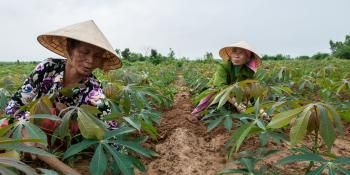Contextual and universal: Scaling context-specific climate-smart agriculture

Is it paradoxical to say that climate-smart agriculture practices are context-specific and scalable at the same time?
To resolve this paradox on climate-smart agriculture (CSA), researchers from the World Agroforestry Centre (ICRAF) and Vietnam University of Agriculture examined the case of My Loi Climate-Smart Village (CSV) in Ky Anh District, Ha Tinh Province, Vietnam. Instead of treating CSA practices as a whole, they split these practices into technologies—“how things are grown”—and components—"what is grown.”
Through this approach, the researchers identified five farming systems that can be integrated into a CSA practice and then scaled out to Ky Trung Commune, located in the same district. They concluded that while the (‘what’) components of integrated farming systems often are context-specific, depending on e.g. soils, slopes and local climate, the (‘how’) technologies applied in such practice often are more general, such as intercropping, contour-planting and mulching. This finding offers an answer to the question on the paradoxical nature of claims about CSA.
From monoculture to integrated farming systems
The study defined CSA technologies as the scalable system (e.g., monoculture, intercropping) that determines the crops to be planted; CSA components refer to the context-specific tree-crop combinations that farmers can plant.
Working with these definitions, the study selected five farming systems that can easily be accepted and later adopted by farmers: intensified rice farming system, sustainable annual crops, tea-based agroforestry system, acacia-based tree plantation, and multistory gardens. All of these farming systems diversify the farmers’ production, income, and nutrient intakes. They also foster efficient use of resources and strengthen the capacity of farms to withstand droughts.
One way to intensify a farming system involves adding one crop season. In some places there is not enough water for two crops of rice, however, intercropping maize with legumes that cover the soil and thereby reduce evaporation can be done during the drier period. In fact, annual crops such as cassava, peanut, and maize can be intercropped throughout the year. A tea-based agroforestry system involves tea, a shade tree such as Senna siamea or Aquilaria crassna, and green bean or grass, depending on the season. An acacia-based tree plantation incorporates acacia with Canary wood and jackfruit. Multistory gardens include fruit trees with grass and vegetables.
The selection of the farming systems hinged on how farmers respond to emerging issues on their farms. Their responses are based on their knowledge and experiences, which were synthesized through a participatory methodology involving quantitative and qualitative methods. Through this methodology, the study aimed to develop climate-smart practices via integration of local and scientific knowledge. In this regard, the study presented the benefits of adopting the selected farming systems based on the perceptions of the farmers and the comments of experts.
Building on enabling conditions
However, regardless of how participatory the the entire CSA development process is, issues still arise on land, labor, and capital—the three basic factors of production. Firstly, farmers may believe that their lands are unsuitable for higher-value CSA practices. Secondly, low-value monocultures are often associated with cheaper but environmentally destructive management methods, such as clear-felling. Lastly, many cannot afford the shift to CSA practices if it involves a few years before investments pay back, such as when trees are introduced. Compounding these issues are the policies that limit CSA adoption, both in terms of what is grown, and how.
To address these issues on CSA adoption, the study provided the following enabling conditions:
- gradual transition to CSA practices that changes either the technology or component instead of an instant shift that changes both at the same time;
- policies that enable CSA adoption;
- land-use plans and support programs that enable mixed annual and perennial land use
- access to low-interest loans or investments with longer return periods; and
- short-term, stress-tolerant varieties and crops that can be adjusted with seasonal forecasts.
The researchers also organized a training on CSA for a range of stakeholders in the district and provincial levels. Through the training, the researchers also aimed to mold future advisors and champions who will further promote climate-smart practices to farmers.
In promoting CSA, the study emphasized that it is not a stagnant solution, but rather “an ongoing, collaborative process.” CSA requires the technical expertise of organizations such as the CGIAR Research Program on Climate Change, Agriculture and Food Security (CCAFS), the financial backing of donor organizations, the political support of government offices, and most importantly, the willingness of farmers—who belong to the most vulnerable sectors to climate change—to adopt and scale climate-smart practices.
Download the publication: Elisabeth Simelton, Tham Thi Dao, An The Ngo, and Tam Thi Le, “Scaling Climate-smart Agriculture in North-central Vietnam.” World Journal of Agricultural Research, vol. 5, no. 4 (2017): 200-211. doi: 10.12691/wjar-5-4-2.
Read More:
- Working paper: Participatory identification of climate-smart agriculture priorities
- Blog: Climate-smart agriculture as a means to combat drought and desertification
- News Update: Scalable climate-smart agriculture technologies and practices that communities can adopt
Renz Louie Celeridad is the Junior Communications Specialist for the World Agroforestry Centre Philippines. He also works as a Communications Consultant for CCAFS SEA.



